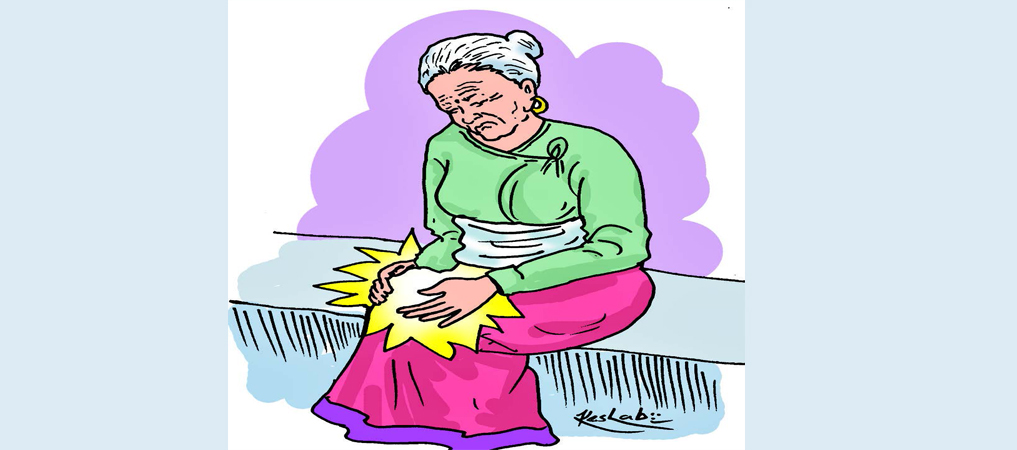Brittle bones: The agony of osteoporosis in old women

By Aashish Mishra
Lalitpur, Feb. 26 Every winter, Niru Maya Basnyat suffers from joint and back pains. Her knees and lower back hurt so much that she can barely stand or walk without support.
Basnyat, 81, remembers that the pain started when she was around 50 years of age. “Having suffered from this for more than 30 years, I don’t remember what it’s like to not have joint pains,” she exclaimed, trying to wiggle into a more comfortable sitting position on her mat.
She lets out moans of pain every time she tries to move or get up. “The pain is just that bad,” she cries.
Basnyat’s ailments trouble her daughter-in-law Sujeeta Basnyat. She is worried about her mother-in-law’s health but at the same time, is also scared about her future condition. At 48 years old, Sujeeta has also started experiencing mild joint pains and is afraid that they might get worse with her growing age.
“My pains also seem to get progressively worse with every winter,” she said rubbing her fingers on her forehead, “I fear that I may be bed-ridden by the time I am in my 70s.”
Sujeeta’s deepest fear, however, is that she might have no one to take care of her. Her only son lives in the US with his wife and children and only comes to visit once every three or four years. So, she is worried about her future prospects.
Joint pain, medically known as osteoporosis, is a condition characterised by low bone mass and loss of bone tissue that may lead to weak and fragile bones. Osteoporosis is not exclusive to any particular gender but it does disproportionately affect women, particularly older women. In fact, studies suggest that one in two women above the age of 50 suffer from some form of osteoporosis.
“This is because women of that age group have undergone menopause and have lower oestrogen levels,” Dr. Dibasha Adhikari, medical officer at Patan Hospital, Lagankhel, stated. “Lack of oestrogen increases women’s risk for osteoporosis,” she further explained.
According to Dr. Adhikari, the lack of oestrogen along with other age-related changes in hormone levels and endocrine functions, and the inactive lifestyle that usually accompanies old age, makes osteoporosis a particularly acute disease for women.
With respect to treating the disease, Dr. Adhikari informed that the treatment regime focused on slowing down or stopping mineral loss and increasing bone density. So, she outlined mineral supplements and therapy as the best options.
“Patients should take Calcium and Vitamin D supplements to boost their intake of these minerals,” she said, adding, “Certain weight-bearing exercises and physical therapy also help.”
Bimal Pradhananga, a physical trainer who offers home therapy services to men and women with osteoporosis, explained how therapy was an easy and inexpensive way to build bone density and relieve the pain.
“It doesn’t require much medication or special machinery and can be done at home with a few tweaks to the lifestyle,” he said.
According to Pradhananga, doing sit-ups or other exercises that require muscles to pull on our bones, walking or jogging a few kilometres every day or riding a bicycle can help build bone density. But he emphasised that people consult a doctor or a professional therapist before beginning any exercises.
“People need specific therapy suited to their specific type of joint pain and any other pre-existing condition that they might have. So, they should consult with their doctor about their exercise routine,” he said.
However, prevention is better than cure, stated Dr. Adhikari who urged people to be mindful of the disease from a young age. “Young people should drink milk and eat calcium-rich food to meet their daily calcium requirement (1,000 mg), perform exercises like walking and swimming and maintain a normal body weight,” she said.
She also called on post-menopausal women to seek medical care if they start developing pain in areas like the neck and lower back.
Furthermore, she explained that osteoporosis can be hereditary so people should remain vigilant if they have a parent with the disease.
Recent News

Do not make expressions casting dout on election: EC
14 Apr, 2022
CM Bhatta says may New Year 2079 BS inspire positive thinking
14 Apr, 2022
Three new cases, 44 recoveries in 24 hours
14 Apr, 2022
689 climbers of 84 teams so far acquire permits for climbing various peaks this spring season
14 Apr, 2022
How the rising cost of living crisis is impacting Nepal
14 Apr, 2022
US military confirms an interstellar meteor collided with Earth
14 Apr, 2022
Valneva Covid vaccine approved for use in UK
14 Apr, 2022
Chair Prachanda highlights need of unity among Maoist, Communist forces
14 Apr, 2022
Ranbir Kapoor and Alia Bhatt: Bollywood toasts star couple on wedding
14 Apr, 2022
President Bhandari confers decorations (Photo Feature)
14 Apr, 2022











